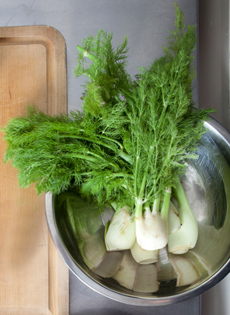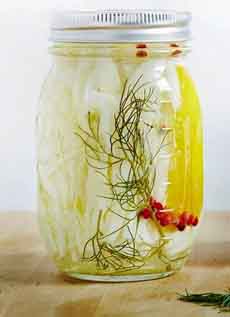RECIPE: Pickled Fennel (Fennel Pickles)
 A head of fennel. The white portion is the bulb, the feathery green tops/stems are the fronds. Photo courtesy Valerie Confections. |
We’ve always loved fennel in a salad (like cucumber salad or this Orange-Fennel Salad) or on a crudité plate. But we never thought to pickle it until we saw this recipe from Quinciple, which makes weekly deliveries of the freshest seasonal produce. Fennel makes such a charming, crunchy pickle that we began to make it as house gifts. It’s made without sugar, and is low in sodium: a win for everyone! Quinciple recommends the pickled fennel in and on: Ingredients For 1 Pint |
|
|
Preparation 1. CUT off the fennel leaf stalks just above where the bulb ends and the fronds begin. Reserve 3-4 of the prettiest leaf fronds; wash and set aside. 2. TRIM off the bottom of the bulb and, if bruised, the outer layer. Give the bulbs a quick rinse. Slice them in half lengthwise, then cut the fennel into ¼-inch-wide slices. 3. PLACE the fennel fronds, zest and peppercorns into a clean pint jar, making sure they are arranged nicely against the glass. Add the fennel slices. Make sure there is ½” of headroom above the fennel. 4. COMBINE the vinegar, water and salt in a small pot and bring to a boil. Pour the boiling brine over the fennel. Let cool, cover tightly with the lid and place in the fridge. The pickles will keep for about 2 weeks. Fennel is in season from fall to early spring. It’s crunchy like celery, with a slight anise taste. |
 Elegant and yummy fennel pickles. Photo and recipe courtesy Quinciple. |
|
|
A member of the parsley family, fennel (Foeniculum vulgare) and celery (Petroselinum crispum) are botanical cousins, members of the same order* (Apiales) and family* (Apiaceae). Both are believed to be indigenous to the shores of the Mediterranean, growing wild before they were cultivated. Records of fennel’s use date back to about 1500 B.C.E, although it has been enjoyed by mankind for much longer. Fennel is highly aromatic and flavorful, with both culinary and medicinal uses. The bulb and stalks resemble celery, the leaves look like dill (Anethum graveolens, also of the same order and family), and the aroma and flavor resemble sweet licorice (Glycyrrhiza glabraa, a totally different order [Fabales] and family [Fabaceae]). Fennel can be substituted for celery in recipes when an additional nuance of flavor is desired. We also enjoy it as part of a crudité plate. The fronds make a lovely plate garnish, and can be dried and used as herbs. Fennel seeds are a popular spice, for baking, bean dishes, brines, fish, pork, sausages and much more. We especially like them in cole slaw and cucumber salad. Plain and sugar-coated fennel seeds are used as a spice and an after-meal mint in India and Pakistan.
|
||


